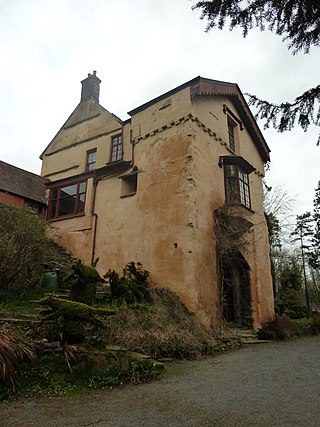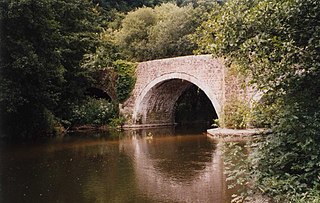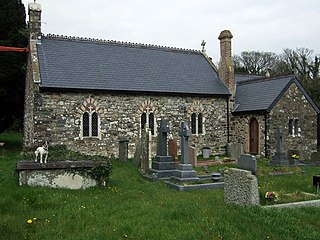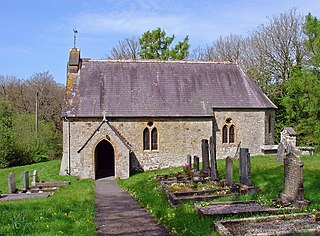
Ewenny Priory, in Ewenny in the Vale of Glamorgan, Wales, was a monastery of the Benedictine order, founded in the 12th century. The priory was unusual in having extensive military-style defences and in its state of preservation; the architectural historian John Newman described it as “the most complete and impressive Norman ecclesiastical building in Glamorgan”. Following the Dissolution of the Monasteries, parts of the priory were converted into a private house by Sir Edward Carne, a lawyer and diplomat. This Elizabethan house was demolished between 1803 and 1805 and replaced by a Georgian mansion, Ewenny Priory House. The house is still owned by the Turbervill family, descendants of Sir Edward. The priory is not open to the public apart from the Church of St Michael, the western part of the priory building, which continues to serve as the parish church for the village. The priory is in the care of Cadw and is a Grade I listed building.

Penally is a coastal village, parish and community 1 mile (1.6 km) southwest of Tenby in Pembrokeshire, Wales. The village is known for its Celtic Cross, Penally Abbey, the neighbouring St. Deiniol's Well, WWI Practice trenches, and Penally Training Camp.

Warren is an ancient parish in the community of Stackpole and Castlemartin, in the most southerly part of Pembrokeshire, Wales. Its northern edge is 5 miles (8 km) south of Pembroke and its southern edge reaches the sea at Flimston Bay. It is bordered by Castlemartin to the west, St Twynnells to the east and Monkton to the north.

Castle House in Usk, Monmouthshire, Wales, originally formed the gatehouse to Usk Castle. Much altered in the eighteenth and nineteenth centuries, it is now a private home and a Grade I listed building.

This is a list of Grade I-listed buildings in the county of Pembrokeshire, Wales.

Prendergast is a former village and parish in Pembrokeshire, Wales, now a suburb of Haverfordwest, Pembrokeshire's county town. The name survives as an electoral ward of Haverfordwest. The Western Cleddau forms the parish's western boundary, and the Hiog, a tributary of the Cleddau, the eastern boundary.

Brynberian is a small village in north Pembrokeshire, Wales, in the foothills of the Preseli Mountains in the Pembrokeshire Coast National Park. It is in the community of Eglwyswrw and the parish of Nevern, and is on the B4329 road between Crosswell and Tafarn y Bwlch. Afon Brynberian flows through the village under an ancient bridge and joins the River Nevern to the north.

Llawhaden Bridge is a Grade II* listed medieval stone arch bridge spanning the Eastern Cleddau river near Llawhaden village in Pembrokeshire, Wales, in the community of Llawhaden and about 1 mile (1.6 km) upstream of the river's tidal limit at Canaston Bridge. It is a scheduled ancient monument.

Manorowen is a small settlement and parish on the A487 2 miles (3.2 km) southwest of Fishguard, Pembrokeshire, West Wales, in the Community of Scleddau; the parish includes the village of Scleddau—the eastern part of which is in the neighbouring parish of Llanstinan. A listed property bears the name of the parish, and the church is dedicated to St Mary.

Glandwr is a small rural village in the parish of Llanfyrnach and the community of Crymych, Pembrokeshire, Wales. The village appears on a pre-1850 parish map as Glan-dwr. It is linked by unclassified roads to adjacent settlements and to the A478 road.

Carswell Medieval House is a Grade II*-listed historic stone ruin of a medieval tenant farm in the village of Penally, near St Florence in Tenby. Visit Wales describe it as "one of the only buildings of its type still standing in this part of Wales" and an example of "everyday medieval life away from the grand castles often associated with the period."

The Church of St Michael and All Angels, Castlemartin, Pembrokeshire, Wales is a redundant church dating from the 13th century. A Grade I listed building, the church is now in the care of the Friends of Friendless Churches.

The Church of St Dogfael, Meline, Pembrokeshire, Wales is a redundant church dating from the 19th century. A Grade II listed building, the church is now in the care of the Friends of Friendless Churches.

Llandrinio Bridge, Llandrinio, Powys, Wales, is a road bridge over the River Severn. Constructed between 1769 and 1775, the bridge is attributed to John Gwynn of Shrewsbury, a noted local architect who designed a number of crossings over the Severn, as well as Magdalen Bridge in Oxford. The bridge is also the site of defensive structures dating to World War II, including a pillbox disguised as an agricultural cowshed and Dragon's teeth tank traps at its northern end. The bridge is a Grade I listed structure and a Scheduled monument.

St Michael's Church is a parish church in the town of Aberystwyth, Ceredigion, Wales. St Michael's is the fourth church to stand on the site. The first dated from the 15th century but was in ruins by the mid-18th century. Its replacement only stood for some forty years before itself being replaced in 1829-1833 with a church designed by Edward Haycock Sr. of Shrewsbury. Nothing of the two earlier buildings remains. The Haycock church was itself superseded by the present church, built by Nicholson & Son of Hereford in 1886-1890. A fragment of the Haycock church remains to the west of the current building.

Pembrokeshire is a county in the south-west of Wales. It covers an area of 1,619 km2 (625 sq mi). In 2021 the population was approximately 123,700.

The Old Vicarage is a house dating from the medieval period in the community of Glasbury, Powys, Wales. Now a private house, it is a Grade I listed building.

Porth-Mawr is a gatehouse on Brecon Street in the centre of Crickhowell, Powys, Wales. Constructed in the 15th century by a branch of the Herbert family as the entrance to their Tudor mansion of Cwrt Carw, it is a Grade I listed building.
West Tarr Mediaeval House is a historic site south of the village of St Florence, in the community of Penally, Pembrokeshire, Wales. The site consists of two structures, the remains of the house and an ancillary building. The house is a Grade I listed building and a Scheduled monument. The outbuilding is listed at Grade II.

The Tower at Eastington Manor is a historic site south of the village of Rhoscrowther, in the community of Angle, Pembrokeshire, Wales. The tower is to a tower house plan and dates from the 14th or 15th centuries. A range of later buildings is attached. The tower is a Grade I listed building and a Scheduled monument. The range is listed at Grade II.


















